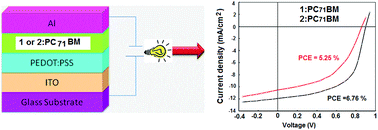We report the synthesis, characterization, and optical and electrochemical of properties of two novel molecules DRT3-BDT (1) and DTT3-BDT (2), comprising the same BDT central core (donor) and different end capped acceptor units, i.e. rhodanine with ethyl hexyl and thiazolidione with ethylhexyl, respectively, linked via an alkyl-substituted terthiophene (3 T) π-conjugation bridge. The electrochemical properties of these small molecules indicate that their energy levels are compatible with energy levels of PC71BM for efficient exciton dissociation. These molecules have been used as electron donors along with PC71BM as an electron acceptor, for the fabrication of solution processed “small molecule” bulk heterojunction (BHJ) solar cells (smOPV). The device prepared from optimized 1 :
: PC71BM(1
PC71BM(1 :
: 1) processed cast from DIO (3%v)/CF solvent exhibited a power conversion efficiency of 6.76% with Jsc = 11.92 mA cm−2, Voc = 0.90 and FF = 0.63. The device with 2
1) processed cast from DIO (3%v)/CF solvent exhibited a power conversion efficiency of 6.76% with Jsc = 11.92 mA cm−2, Voc = 0.90 and FF = 0.63. The device with 2 :
: PC71BM under the same conditions showed a lower PCE of 5.25% with Jsc = 10.52 mA cm−2, Voc = 0.86 and FF = 0.56. The AFM, TEM and PL quenching measurements revealed that the high Jsc is a result of the appropriate morphology and exciton dissociation. The performances were compared for the devices based on two small molecules. The higher Jsc for device 1 was attributed to its better nanoscale phase separation, smooth surface and higher carrier mobility in the 1
PC71BM under the same conditions showed a lower PCE of 5.25% with Jsc = 10.52 mA cm−2, Voc = 0.86 and FF = 0.56. The AFM, TEM and PL quenching measurements revealed that the high Jsc is a result of the appropriate morphology and exciton dissociation. The performances were compared for the devices based on two small molecules. The higher Jsc for device 1 was attributed to its better nanoscale phase separation, smooth surface and higher carrier mobility in the 1 :
: PC71BM blend film. Moreover, the higher value of FF for the 1
PC71BM blend film. Moreover, the higher value of FF for the 1 :
: PC71BM based device was ascribed to a good balance between the electron and hole mobilities.
PC71BM based device was ascribed to a good balance between the electron and hole mobilities.
